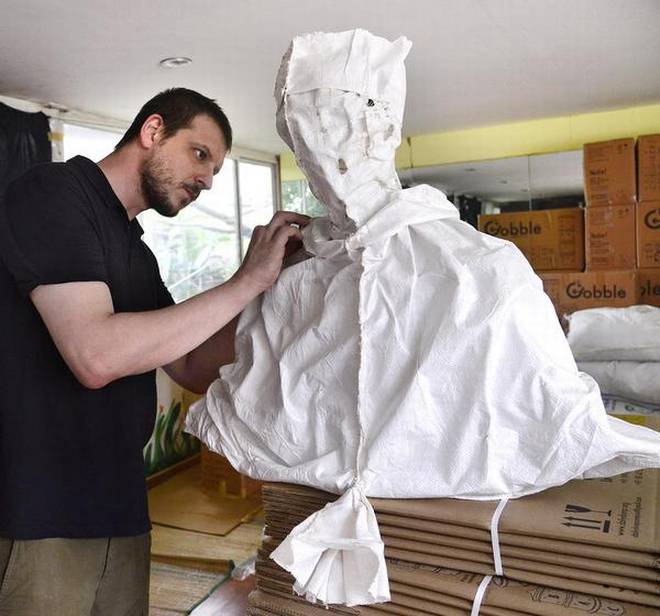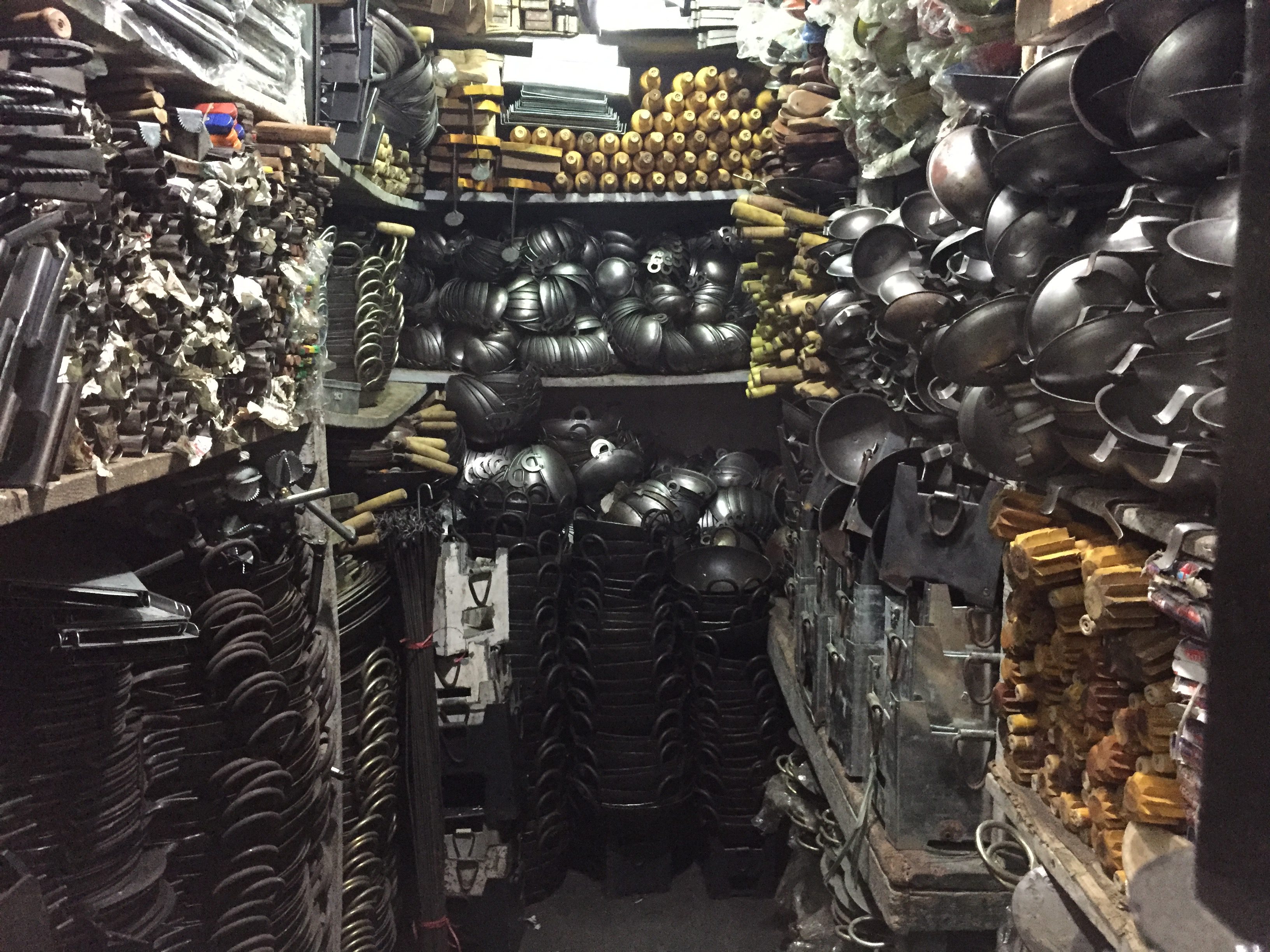

Whether it is re-presenting the cow goddess or an ubiquitous shop in the market, Francesco Petruccelli and Bernd Lützeler’s current art project present their version of India, writes Priyanka Sacheti
In his studio at Daily Dump, Bangalore, sculptor, Francesco Petruccelli is putting the finishing touches to his sculpture which will be on show at the city’s Goethe Insitut-Max Mueller Bhavan. Petruccelli is one of the 12 residents currently pursuing the bangaloREsidency, a project which was conceived as a long-term collaboration between the Goethe-Institut / Max Mueller Bhavan Bangalore and various contemporary art/cultural spaces and partners. The aim of the project is to offer German artists the opportunity to interact with their Indian counterparts as well as find a conducive space in which to create their art.
Petruccelli is working on the relationship between art and trash, perceiving the latter, especially plastic, holding immense creative potential. “Both art and trash are examples of human production. However, while art figures at the summit of cultural activity and production, trash lies at the very bottom,” he says, elaborating that art is revered in the holy temples of galleries whereas trash ends up in a dump. “There is therefore a kind of symmetry between both art and trash. And then there is the all important question of time and how it blurs the distinctions between trash and art. If you drop a pen on the pavement today, it will become trash – and yet, hundreds of years later, when excavated from earth, it will be showcased in a museum as an example of cultural production,” he points out.

Both art and trash are examples of human production. However, while art figures at the summit of cultural activity and production, trash lies at the very bottom, says Francesco Petruccelli
Focusing on the merging of these two parallel and disparate modes of human production, Francesco has spent the first month of his two month residency working on a sculpture wrought from melted black plastic trash bags, inspired by the Dutch painting genre of hunting still life. “The slaughtered animal – cow, ox or lamb – is a very common theme in the European art,” he states, saying that it is a symbol of pain and brutality of life.“It is also an all important metaphor of the Passion of Christ and of the suffering of human kind. Last, but not least: it’s food,” he mentions.
Petruccelli mentions that he is intent on locating a nexus between Western and Indian traditions during his residency. In this particular work, the sculptor invokes the Kamadhenu, the divine bovine goddess described in Hinduism as the mother of all cows to examine the despoiling of nature. “Nature provides sustenance to humans as well as representing the cycle of life,” he says. “But what have we done to nature? We are destroying, spoiling, violating, and killing nature. We are becoming butchers, killing something so good,” he says, this figurative dead goddess’ plastic skin referring to the destruction of nature’s purity. “It is a depiction and representation of something good getting destroyed, something which is common all over the world,” he emphasises.
The cow in India is sacred and revered, cast in a maternal mould and yet also, a polarising political entity. Petruccelli’s sculpture visits the cow in a radically alternate context, exploring how what is food elsewhere becomes a taboo, a symbol of mortality metamorphosing into an untouchable deity – and yet Petrucelli pertinently asks, is the destiny of Kamadhenu so different after all from the brutal sacrifice depicted by European artists? The destruction of nature is a sacrifice that is not even caused by the need for food: it’s a meaningless process that is actually leading humans to very painful consequences.“I wanted to create a symbol of a very corporeal nature and yet would powerfully communicate abstract ideas. It is particular and yet not easily definable; it is a cow – and yet not a cow,” he remarks.
Given that he has a month left to pursue the second part of his residency, Francesco says that the shape that his next work will assume depends on the material and length of time he will have access to. “The idea is still embryonic but I am thinking of focusing on recycled plastic and the people who make the plastic itself,” he says, adding that he’s questioning about the life and death of trash and rebirth of plastics. He envisions the second sculpture involving the process of plastic production, specifically the plastic bags which become little plastic pellets that are subsequent sold to factories which produce plastic objects from it. “I would like to highlight the human story underlying the plastic through the sculpture, in addition to situating it amid the factories that they work in,” he concludes, intent on bringing together he material, the object, and the human endeavor involved in creating it.
If Petruccelli desires to depict the human element underlying the narrative of plastic production, German artist and film-maker, Bernd Lützeler is focusing on the objects themselves and the shops that they are placed in. The film he is working on will explore the interiors of small shops in the city’s markets, especially those that are cluttered with objects, filling the space to the maximum. “I have been pregnant with this project for quite a while, but it would have been much more difficult to execute the idea in Bombay – and so when I got the opportunity to apply for this Bangalore residency, I thought of doing it here,” he says.
Having spent the first three weeks of his residency on a location recce, Lützeler along with his crew consisting of students of Srishti Institute of Art, Design and Technology combed through the various markets of the city such as KR Market, Shivaji Nagar, Commercial Street, and Russel Market, identifying and shortlisting shops and conjuring up a visual idea of Bangalore markets’ retail landscape.
“Apart from documenting the shops, the film also intends to be a commentary on how these shops are dominating, defining, and designing the Indian visual urbanscape,” he says, showing me a series of images of the shops captured on his phone: gleaming steel utensils, iridescent sari blouses, plastic flowers, and also, one particularly surreal image of undressed mannequins huddled together. Besides the references to popular Indian culture and life in urban India nowadays, Lützelers’ works often examine techniques of moving image production and presentation in relation to their form and perception; loops are one of the integral aspects of his work and this film too will be presented in loop format.

Meanwhile artist and film-maker, Bernd Lützeler is focusing on the objects themselves and the shops that they are placed in
After completing his recce, the crew will be shooting in 30 locations for the last two weeks of his residency, aiming to film 2-3 shops every day. “The filming is not without its challenges. It’s the festive season, Navratri and Diwali coming up…there are people constantly coming and going in an already crowded space along with lighting issues,” he says. The fact that Lützeler is shooting the film in 16mm is also unusual in India. “There is a lack of infrastructure relating to it, not many know how to operate the camera here in Bangalore and those who do are much older and often retired,” he says, adding that in his first week, he conducted a workshop for the crew regarding operating the camera. Nevertheless, he feels that the 4×3 format of the 16 mm camera will do great justice to these shops’ characteristic interior dimensions.
Remarking on how many shops are flooded with innumerable products from China, the film also raises questions of consumerism and excess. “However, we also observed that many shops are closed or about to close down. The shopkeepers are complaining that their business has gone down thanks to Amazon and Flipkart. So in the long run, the evolving online market might even change the appearance of entire Indian cityscapes,” Bernd says, mentioning that the film may end becoming an archive of these shops
Whether it is re-presenting the cow goddess or an ubiquitous shop in the market, these German artists present their version of India, a cumulative byproduct of the country, cultures, and communities they engage with. Their primarily Indian audience in turn re-sees what they might otherwise have taken for granted or associated in a singular way, creating a multi-dimensional way of examining and understanding situations.